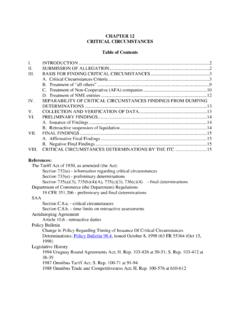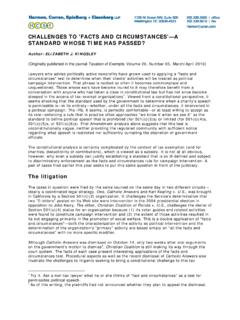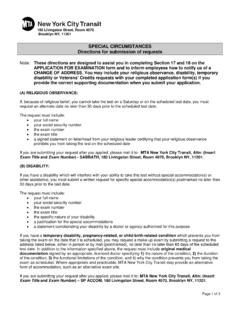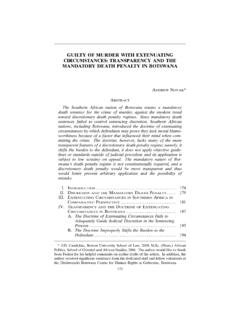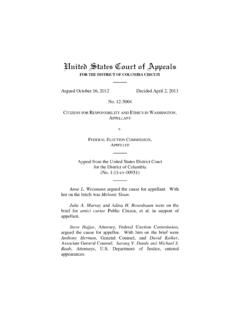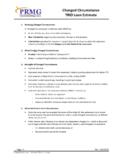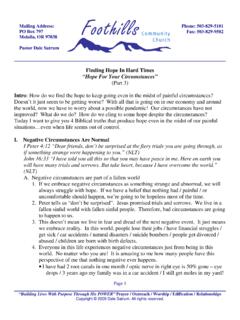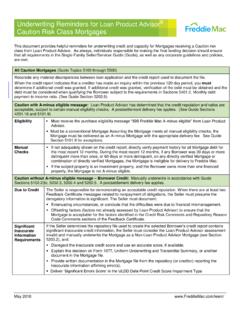Transcription of Internal Revenue Service Memorandum
1 Office of Chief CounselInternal Revenue ServiceMemorandumNumber: 201208027 Release Date: 2/24/2012CC:PA:06:RLGregoryPOSTF-128317- 11 date: November 2, 2011 to: Frances F. ReganArea Counsel 1 (Manhattan) (Small Business/Self-Employed) from: Barbara M. PettoniSenior Technical Reviewer(Procedure & Administration) subject: Applicability of Mitigation Provisions to Net Operating LossesThis Chief Counsel Advice responds to your request for assistance. This advice may not be used or cited as precedent. This writing may contain privileged information. Any unauthorized disclosure of this writing may undermine our ability to protect the privileged information.
2 If disclosure is determined to be necessary, please contact this office for our the mitigation provisions, found in 1311 through 1314, may be applied to allow a barred refund after an audit resulted in an increased net operating loss properly carried to a closed is currently examining an S Corporation1 and its sole shareholder, the taxpayer, for taxable years 2005 and 2006 ( Exam ). For taxable year 2005, both the S Corporation s Form 1120S, Income Tax Return for an S Corporation, and the taxpayer s Form 1040, Individual Income Tax Return, reported a net 1 An S Corporation is a small business corporation for which an election has been made under section 1362(a) for the taxable year.
3 1361(a)(1). POSTF-128317-112operating loss (NOL). The taxpayer s NOLreported on his Form 1040 for year 2005 was carried back to, and completely absorbed by, taxable years 2003 and 2004. For taxable year 2006, both the S Corporation s Form 1120S and the taxpayer s Form 1040 reported an NOL. The taxpayer s NOL reported on his Form 1040 for year 2006 was carried forward by the shareholder to taxable year 2007 and was absorbed in taxable year 2008. The 2006 Form 1040 included a statement in accordance with 172(b)(3), making an irrevocable election to forego the carryback of the net operating losses reported in the Exam, the Revenue agent made adjustments to the Forms 1120S and Forms 1040.
4 For taxable year 2005, the Revenue agent s adjustments resulted in income tothe S Corporation and the shareholder. For taxable year 2006, the Revenue agent s adjustments resulted in an increased lossfor the S Corporation. This created an increased NOL and Alternative Minimum Tax ( AMT ) NOLon the shareholder s Form 1040 fortaxable year 2006. Due to the irrevocable election made by the taxpayer pursuant to section 172(b)(3), this increased loss must be carried forward. The Service did not open the year 2007 Forms 1120S and 1040 for statute of limitations for assessing tax on the Form 1040 and the Form 1120S for taxable year 2007 expired on April 15, 2011.
5 The statute of limitations for claiming a refund for year 2007 also expired on April 15, 2011. The Form 1040 for taxable year 2007 showed negative taxable income and no income tax; however, the return also showed AMT due (such amount was self-reported, and assessed by the Service ).A Revenue agent s report ( RAR ) was issued to the shareholder in February 2011, showing the NOL and AMT NOL from taxable year 2006carried back to taxable years 2004 and 2005. The report showed theNOL and AMT NOLabsorbed in full in 2004 and 2005. Neither the shareholder nor the agent signed the RAR. The result of the Exam will not be the result proposed in the taxable year 2007, the taxpayer had negative taxable income; however, the taxpayer had paid AMT.
6 Carrying the 2006 losses forward pursuant to the taxpayer s election, the taxpayer s AMT for taxable year 2007 would be zero. But for the statute of limitations ( SOL ), the taxpayer would receive a refund in the amount of the AMT paid for taxable year 2007. However, the SOL for assessment of tax liability and for claiming a refund for such year is now closed. Examination has asked whether the mitigation provisions of the Code apply to the facts presented such that the taxpayer can receive a refund of the AMT paid in taxable year 2007. LAW AND ANALYSISS ection 172(a) authorizes a net operating loss (NOL) deduction.
7 An NOL is defined as the excess of allowable deductions over gross income, with specified modifications. 172(c) and (d). The modifications for purposes of computing POSTF-128317-113an NOL include an exclusion of personal exemptions and non-business deductions of taxpayers other than corporations (except to the extent of income that is not derived from a trade or business). 172(d)(3) and (4). Section 172(a) allows an NOL deduction for the aggregate of NOL carrybacks and carryovers to the taxable year. Section 172(b)(1)(A) generally provides that the period for a carryback is 2 years and that the period for a carryover is 20 years.
8 A taxpayer may elect to waive the carryback period, but only if he files an election to do so by the due date (including extensions) of the return for the year in which the carryback NOL is generated. 172(b)(3). Otherwise, the NOL must be carried to the earliest of the taxable years to which it may be carried, and it offsets taxable income for that year. 172(b)(2). In the case of AMT NOLs, the rules for those NOLs run parallel. See 56; Allen v. Commissioner, 118 1, 16 17 (2002).In this case, the taxpayer made an irrevocable election in taxable year 2006 to forgo the carryback period. Thus, the net operating losses and AMT net operating losses ( losses ) cannot be carried back to taxable years 2004 and 2005, as proposed in the RAR prepared by the Revenue agent in February 2011.
9 Rather, the losses mustbe carried forward to taxable years 2007 and later years consistent with the taxpayer s election and in accordance with section 172(b)(3). However, because the statute of limitations for assessment of a tax liability and for filing a claim for refund for taxable year 2007 expired on April 15, 2011, the taxpayer cannot receive a refund of taxes for 2007. See 6501(h) & 6511(a). Thus, we look to the mitigation provisions of 1311 through 1314 to determine whether relief is available in the situation mitigation provisions of sections 1311 through 1314 of the Internal Revenue Code were designed to palliate the effect of limitations in certain narrowly drawn situations.
10 SeeBradford v. Commissioner, 34 1051, 1054 (1960). For an adjustment to be authorized under the mitigation provisions, there are two threshold requirements. First, there must be a determination. Second, the determination must be described by one of the circumstances of adjustment paragraphs in section 1312. In order for mitigation to apply, additional requirements in sections 1311(a) and (b) must also be met. Because the facts of this case do not meet the threshold requirements, we do not continue to determine if the remaining requirements are Under Section 1313(a)First, there must be a determination for an open taxable year.










